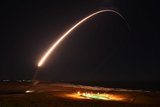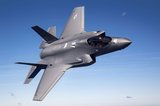Japan defence ministry seeks record budget
Japan's defence ministry on 30 August requested a record $50.3 billion budget to fund purchases of fighter jets and missile defence as the country eyes the threat from North Korea and China.
The 5.32 trillion yen ($50.3 billion) request for the year from April is 1.2% higher than last year's, marking an eighth straight increase.
The funds are intended to pay for big-ticket items, including six F-35B fighters capable of vertical take-off, as well as the upgrade of two existing helicopter destroyers to serve as aircraft carriers for F-35Bs.
The budget also seeks money for the ongoing purchase of US-made Aegis Ashore missile defence systems and the development of a Japanese next-generation fighter jet.
Japan's gradually expanding defence budget reflects the policies of hawkish Prime Minister Shinzo Abe, who has steadily upgraded the nation's military in the face of missile and nuclear threats from North Korea and increased military activity in the region by China and Russia.
Abe has also courted US President Donald Trump by actively purchasing US military products and repeatedly highlighting the Washington alliance as a cornerstone of Japan's diplomacy.
The budget request comes as Japan's relations with fellow US ally South Korea hit a new low over issues related to World War II and Japan's occupation of the Korean peninsula.
But Japanese officials said South Korea's recent decision to scrap a bilateral agreement on military intelligence sharing did not affect the budget request.
The new budget also puts an emphasis on expanding Japan's defence capabilities in ‘new domains, such as space, cyber and electromagnetic spectrum,’ the ministry said in a statement accompanying the draft budget.
The ministry plans a 4.0-billion yen ($38 million) programme to study the use of electromagnetic waves to disrupt communication of enemy forces.
The programme will also include purchases of tools to analyse efforts to interfere with Japanese satellites using electromagnetic waves.
And the ministry wants to develop aircraft and vehicles capable of disrupting radar and radio signals from enemy forces.
The budget foresees the creation of a 20-member ‘space mission’ team to ensure Japan's defence capacity in space, the ministry said.
The team will first train specialists in space defence by analysing activities of other militaries as well as learning from the US force, a Japanese air force official said.
More from Defence Notes
-
![Canada set to look away from its neighbour and across the Atlantic for partners]()
Canada set to look away from its neighbour and across the Atlantic for partners
While non-EU UK struggles to join the Security Action for Europe initiative, which provides loans for defence programmes, Canada has become the first country outside Europe to get access – and did so for a nominal fee.
-
![NATO experiments with solutions to integrate networks, AI and uncrewed systems]()
NATO experiments with solutions to integrate networks, AI and uncrewed systems
During the latest edition of the NATO DiBaX, the alliance tested multiple capabilities to inform requirements for future efforts.
-
![Leonardo unveils plans for Michelangelo air defence dome]()
Leonardo unveils plans for Michelangelo air defence dome
The new multi-layered defence system will harness AI to neutralise airborne threats and protect Europe from Russian aggression.























